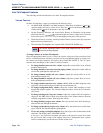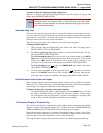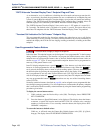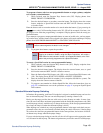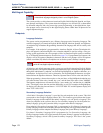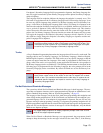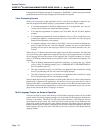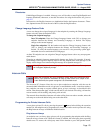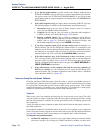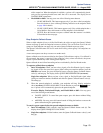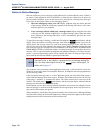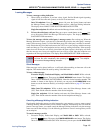
System Features
INTER-TEL
®
CS-5200/5400 ADMINISTRATOR GUIDE, ISSUE 1.1 – August 2005
Page 174 Voice Processing System
Language Do-Not-Disturb message 02 is changed to “PAGE ME,” a similar message should be
programmed for the Secondary Language Do-Not-Disturb message 02.
Voice Processing System
When a voice processing system application receives a call from an endpoint or trunk, the sys-
tem tells the application which language is programmed for that device. For example:
• If a trunk programmed for American English rings in to an application, the voice pro-
cessing system will play the American English prompts.
• If an endpoint programmed for Japanese calls Voice Mail, the user will hear Japanese
prompts.
• If an endpoint programmed for American English receives a call on a trunk that is pro-
grammed for Japanese, and then transfers the call to Voice Mail, the caller (using the
trunk) will hear Japanese voice prompts.
• If a Japanese endpoint is forwarded to Voice Mail, a caller on an American English end-
point or trunk will hear the “American English” prompts (the user-recorded mailbox
greeting will be heard in the language in which it was recorded) when the call is for-
warded.
When using a Call Routing Announcement application with digit translation, the individual
voice processing system applications assigned to the digits can be programmed to override the
device language and provide prompts in one language only. Using this method, you can pro-
gram a Call Routing Announcement tree that offers callers a choice between languages. For
example:
• The Call Routing Announcement application could have a greeting that says, “Thank
you for calling. For English prompts, press 1. NIHONGO WA, 2 WO OSHITE KUDA-
SAI (for Japanese, press 2).”
• The digit translation for digit 1 would lead to an application that overrides the calling
device’s programming and uses only American English prompts.
• The digit translation for digit 2 would lead to an application that overrides the calling
device’s programming and uses only Japanese prompts.
In the example above, the digit translations could be nodes that lead to various other American
English-only or Japanese-only applications. Or, the first level can give more choices, such as
English Voice Mail or Automated Attendant and Japanese Voice Mail and Automated Atten-
dant. Either way, the individual applications or nodes can be programmed to play only one lan-
guage or they can use the device’s language, as needed.
Multi-Language Feature on Network Operation
Nodes do not have to use the same Primary and Secondary languages because the Voice Mail
system installs all existing language prompts, not just prompts for the languages designated as
Primary or Secondary. Therefore, for calls across network nodes, if the language does not
match between the two nodes, the called Voice Mail system searches for the designated lan-
guage in its system in the following order; Primary language, Secondary language, American
English, British English, Japanese, and Spanish and uses the designated language. If the desig-
nated language does not exist in the Voice Mail system, the system uses the default Primary
language instead.



